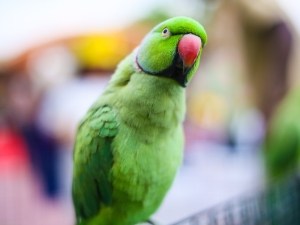
When you picture a ringneck you’re likely thinking of a bird with a red beak, but ringnecks can have black beaks as well
This article is a look into why your ringneck has a black beak
Table of Contents
Why is my ringnecks beak black?
Ringnecks have very distinct-looking beaks, these birds have hooked beaks that look very different when compared to the beaks of other birds.
These birds are also known to have beaks on the brighter side of the rainbow, not black beaks.
Here are the possible reasons why your ringneck’s beak is black.
It’s an African ringneck
While Indian ringneck parrots naturally have beaks that are red to deep purple. African ringnecks are different than Indian ringnecks. African ringnecks have beaks that are black
What to do:
You don’t have to do anything in this case, this is quite normal for this type of bird and you may have simply received a type of bird that you hadn’t expected to get.
It’s a bruise:
If your bird’s beak was always a lighter color and the bird suddenly developed a black patch on its beak then the bird may simply have a bruise on its beak.
Bird beaks are not impenetrable, they can crack and even bruise. The outer layer of bird beaks are made up of a layer of keratin and the inner layer is bone. A layer of capillaries run between these two parts.
If the bird’s beak was injured, if the bird got into a fight and its beak was attacked, if the bird fell on its beak, or if the bird flew into a window or glass door then a bruise could have developed because the bird was injured.
If the beak was injured then this could have caused the capillaries to burst and blood could have pooled just under the keratin layer causing the beak to look black because of the bruise.
What to do:
You don’t have to worry if the bird is using its beak as normal and isn’t showing signs of being in pain while eating. This normal behavior in your bird means that the injury isn’t too bad and the bruise isn’t painful.
The bruise will grow out as the keratin grows and will be worn down as the bird uses its beak.
If the bird can’t eat, and looks as though it is in pain, then take your bird to the vet,
Fatty liver disease:
This is another example of the bird developing a bruise on its beak but this happens because of an ailment called fatty liver disease.
Fatty liver develops in birds who eat a seed-based diet, this condition causes blood clots to develop in the bird’s body and one of these blood clots may have developed in the bird’s beak causing it to look black,
What to do:
This is a common yet very serious condition in your bird and needs a diagnosis from a vet as soon as possible. Take your bird to the vet as soon as you can.
Toys:
If your bird’s toys have started losing their color, and your bird has simultaneously developed a black beak, then the black on your bird’s beak may simply be the coloring coming off of the bird’s toys and rubbing onto the beak.
Your bird likely really loves its toys and likely plays with them a lot, but if the toys are old the paint from said toys may simply be rubbing on your bird’s beak causing it to turn black.
What to do:
You can test this theory out by having a look at your bird’s toys as well as trying to wipe the black off of your bird’s beak.
Do this gently as your bird’s beak may very well be bruised and applying too much pressure may be very painful to the bird.
If you enjoyed this article then you may also be interested in other bird related articles. Here are some articles that you may be interested in: Brown Spot On Budgies Beak, Black Spots On Cockatiel Beak, Red Spot On Budgies Beak, Black Spot On Parakeets Beak, Stripes On Cockatiel Beak,

